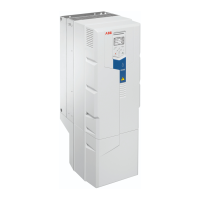Program features 51
Critical speeds/frequencies
Critical speeds (sometimes called “skip speeds”) can be predefined for applications
where it is necessary to avoid certain motor speeds or speed ranges because of, for
example, mechanical resonance problems.
The critical speeds function prevents the reference from dwelling within a critical band
for extended times. When a changing reference (22.87 Speed reference act 7) enters
a critical range, the output of the function (22.01 Speed ref unlimited) freezes until the
reference exits the range. Any instant change in the output is smoothed out by the
ramping function further in the reference chain.
When the drive is limiting the allowed output speeds/frequencies, it limits to the
absolutely lowest critical speed (critical speed low or critical frequency low) when
accelerating from standstill, unless the speed reference is over the upper critical
speed/ frequency limit.
The function is also available for scalar motor control with a frequency reference. The
input of the function is shown by 28.96 Frequency ref act 7.
Example
A pump has vibrations in the range of 540…690 rpm and 1380…1560 rpm. To make
the drive avoid these speed ranges,
• the critical speeds function by turning on bit 0 of parameter 22.51 Critical speed
function, and
• set the critical speed ranges as in the figure below.
Settings
• Critical speeds: parameters 22.51…22.57 (page 159)
• Critical frequencies: parameters 28.51…28.57 (page 172).
540
690
1380
1560
1Par. 22.52 = 540 rpm
2Par. 22.53 = 690 rpm
3Par. 22.54 = 1380 rpm
4Par. 22.55 = 1560 rpm
1234
22.01 Speed ref unlimited (rpm)
(output of function)
22.87 Speed reference act 7 (rpm)
(input of function)

